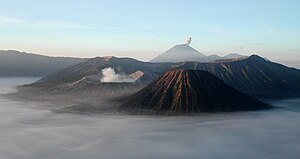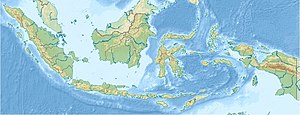Bromo
| Bromo | ||
|---|---|---|
|
Bromo (smoking crater left) with Batok (front right), in the background the Semeru volcano . |
||
| height | 2329 m | |
| location | Java | |
| Mountains | Tengger volcano massif | |
| Coordinates | 7 ° 57 ′ 0 ″ S , 112 ° 57 ′ 0 ″ E | |
|
|
||
| Type | Stratovolcano | |
| Last eruption | 2019 | |
The Bromo ( Indonesian Gunung Bromo ) is a stratovolcano on the Indonesian island of Java . The 2329 m high volcano is the youngest crater of the Tengger volcano massif and one of the most active volcanoes on Java. It is located in the Bromo-Tengger-Semeru National Park and is a popular tourist destination.
location
The Bromo-Tengger massif is part of a volcanic chain that extends along the Sunda Arc . These are volcanoes of a subduction zone , which were created by the sinking of the Indo-Australian plate below the Eurasian plate along the Sunda Trench . The magma rising during this process feeds the volcanoes of this volcanic chain, which stretches from the Andamans through Sumatra and Java to East Timor .
Gunung Penanjakan is a particularly popular viewpoint of Mount Bromo . Semeru, located behind the Bromo, repeatedly sends out small and occasionally larger eruptions within an hour.
Volcanic activity
Two people died in an outbreak on June 8, 2004. On November 23, 2010, a new eruption phase began, a radius of 2 kilometers around the crater was temporarily closed. Special caution was urged on nearby Malang Airport and dust masks were distributed to residents in the area . From November 12, 2015 to November 12, 2016, the volcano erupted again. During this time, Malang Airport had to be closed twice due to volcanic ash.
Another phase of the eruption began on March 10, 2019.
Mythological meaning
The name "Bromo" is derived from the Hindu creator god Brahma . For Indonesian Hindus, especially the Tenggers , the mountain is a pilgrimage destination.
According to one story, at the end of the 15th century, Princess Roro Anteng of the Majapahit empire founded their own principality with her husband Joko Seger . They called it Tengger after the final syllables of their names. The principality flourished, but the ruling couple were unable to produce offspring. So in their desperation they climbed Mount Bromo and prayed to the gods to help them. They promised to help them on condition that their last-born child would be sacrificed to the gods. The two had 24 children and when the 25th and final child, Kesuma, was born, Roro Anteng refused to sacrifice her child as promised. The gods threatened fire and brimstone until she finally sacrificed the child. After it was thrown into the crater, the child's voice ordered locals to hold an annual celebration at the volcano. This festival, called Kassada , is still held today. It mainly consists of a night procession to the summit, where animals, fruits and rice are sacrificed.
literature
- Ernst Spiess: Swiss World Atlas . Swiss Conference of Cantonal Education Directors (EDK), 2008, ISBN 978-3-906744-37-7 .
- Martin Hasler, Hans-Rudolf Egli (Hrsg.): Geography knowledge and understanding . hep, Bern 2004, ISBN 3-03905-056-7 .
Web links
- Bromo in the Global Volcanism Program of the Smithsonian Institution (English)
Individual evidence
- ↑ Peningkatan status Gunungapi Bromo, dari Siaga (Level II) ke Awas (Level IV), tanggal 23 November 2010, pukul 16.30 WIB. ( portal.vsi.esdm.go.id ( Memento from November 27, 2010 in the Internet Archive ))
- ↑ Bromo volcano accessible again. In: The Farang. June 9, 2011. ( farang-magazin.com ( Memento from July 8, 2012 in the web archive archive.today ))
- ↑ Airport urged to check air cleanness following Bromo minor eruptions. In: The Jakarta Post. November 28, 2010. ( thejakartapost.com ( Memento of December 5, 2010 in the Internet Archive ))
- ↑ Residents near Mt. Bromo get masks. In: The Jakarta Post. November 29, 2010. ( thejakartapost.com ( December 1, 2010 memento in the Internet Archive ))
- ↑ Global Volcanism Program, 2016. Report on Tengger Caldera (Indonesia). In: E. Venzke (Ed.): Bulletin of the Global Volcanism Network. 41:12. Smithsonian Institution.
- ↑ Global Volcanism Program, 2019. Report on Tengger Caldera (Indonesia). In: SK Sennert (Ed.): Weekly Volcanic Activity Report. 6 March-12 March 2019. Smithsonian Institution and US Geological Survey.
- ^ Karl Gratzl: Myth Mountain. Lexicon of the important mountains from mythology, cultural history and religion . Hollinek, Purkersdorf 2000, ISBN 3-85119-280-X , p. 58-59 .



